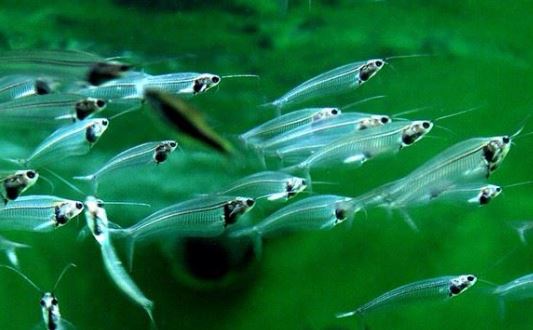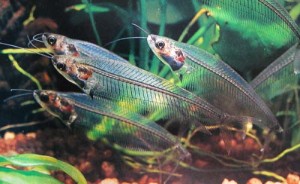

- One of the most unusual looking fish for a tropical community is a Phantom Glass Catfish. They are unusual in that you can see straight through them !!!
- Phantom Glass Catfish have an elongated body with a subterminal mouth that features extended feelers on either side. The anal fin extends almost from the head to the forked caudal fin. The head is a darkened colour, yet they are clear from their gills to the tail. Their bodies are totally devoid of scales.
- Their skeleton is visible when looking side on and with a magnifying glass the heart can clearly be observed beating.
Common Name(s) : Phantom Glass Catfish, Ghost Fish, Ghost Catfish (not to be mistaken with the similar Poorman’s Glass Catfish that features lateral black lines and is not quite as see-through!)
Family : Siluridae
Genus: Kryptopterus
Species : Kryptopterus minor
Origin : Asia – Indonesia in the mainstreams of Borneo
PH : 6.6 – 7.5
Hardness : Soft to Hard
Temperature : 22 – 28°C / 72–82°F
Maximum Size : 8cm
Lifespan : 6-8 years
Aggression Level : Low (2/10)
Recommended Tank Size : 30 Litres +
Strata : Unusually for catfish – middle to top
TANK SET UP
A planted tank suits the Phantom Glass Catfish requirements. Bunch plants like Wisteria, Blue Stricta, Green Pennywort, Purple Temple will create lots of cover and some driftwood anubias plants and some rocks or ornaments will also be beneficial for them too.
These fish do minimal damage to plants for those of you looking for suitable fish for your planted tank.
SUITABLE TANK MATES
- Tropical Fish
- Dwarf Cichlids
DIET
Omnivores, in the aquarium they will take a wide range of foods including flake, pellets, vegetables, bloodworm or brine shrimp.
SEXING AND BREEDING
Sexing Phantom Glass Catfish is pretty much impossible. Your guess is as good as mine, but in the youtube video I have included at the bottom of this article you can observe two Phantom Glass Catfish “dancing” together and circling together which is common pre-breeding behaviour in many other specimens of ornamental fish I have seen.
What is known about their breeding is that they are egg layers and that there have been no reports of them spawning in an aquarium.
My advice to breed them would be to replicate their natural environment in the aquarium as best possible by adding plenty of driftwood, plants, rocks and keep the PH just slightly acidic – maybe about 6.8-6.9 and the temperature around 26°C. Keeping the light off for a few days may well help with the correct conditions.
Keep an eye out for unusual or heightened behavior from the fish, often this might occur after water changes, or if weather low pressure systems are above, certain phases of the moon or even warm weather.
You can document any findings at the blog at the bottom of this page for others to read.
OTHER USEFUL INFORMATION
They do appreciate plants in the aquariums and it is strongly recommended you keep these fish in a school of at least 5-6 to maximize their life.
Tank companions should not be boisterous, tetras, dwarf gourami’s, most cat fish or dwarf cichlids are some that would make fine tank mates. I have also kept them with larger gourami’s, silver dollars and angelfish.
When you first bring Phantom Glass Catfish home from the aquarium shop it is good practice to turn the lights off before adding them. These can be a nervous fish moving into a new aquarium.
I have seen Glass Catfish get white spot a couple of times, probably due to their scaleless anatomy, so ensure your new stock has no visable signs before purchasing from your local aquarium shop and ensure the filtration, temperature, PH and necessary beneficial bacteria are all at sound levels in your home aquarium.

Leave a Reply
You must be logged in to post a comment.